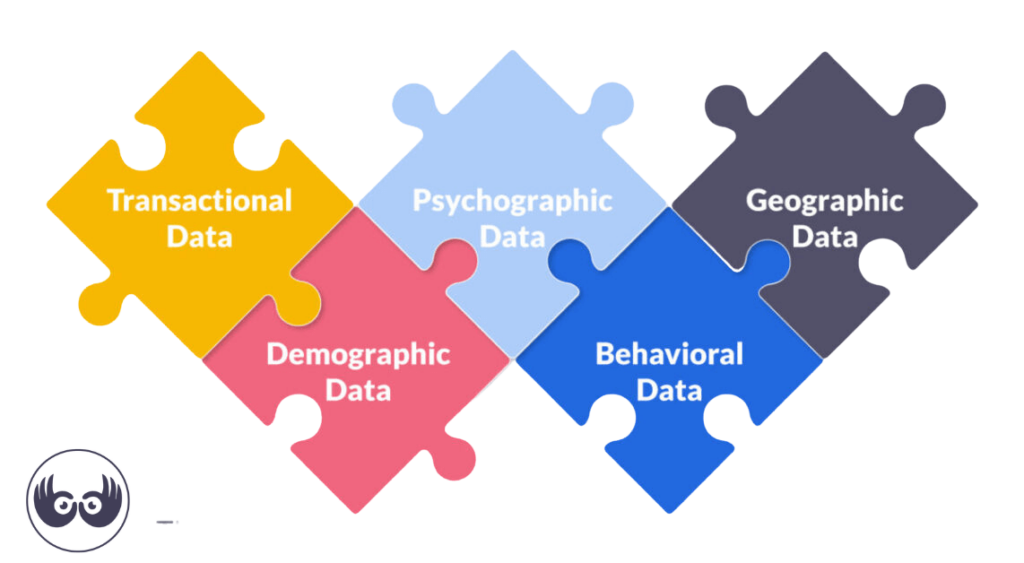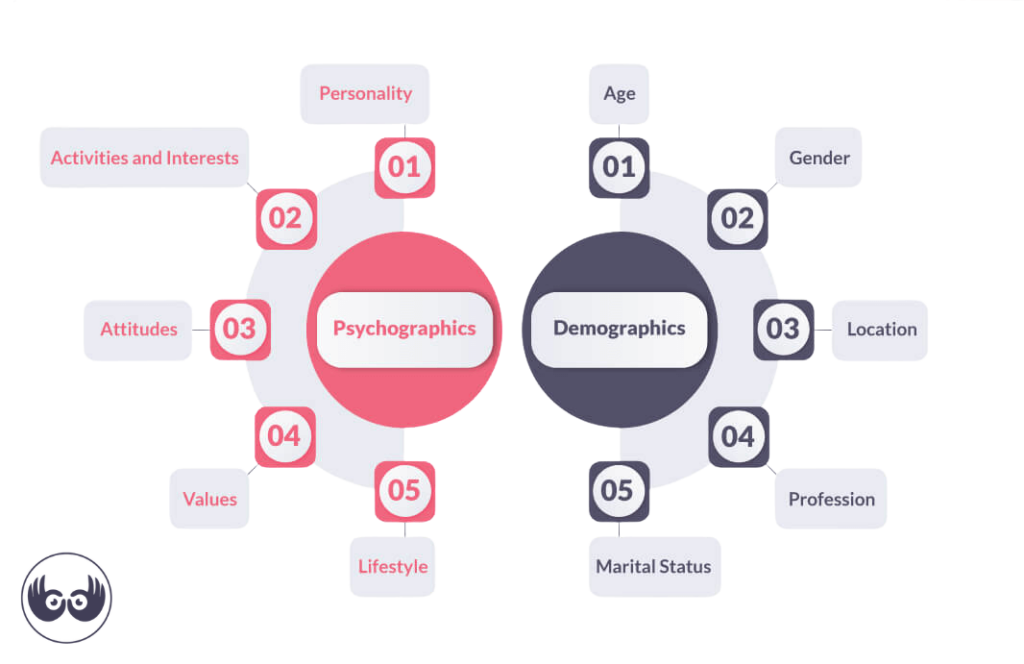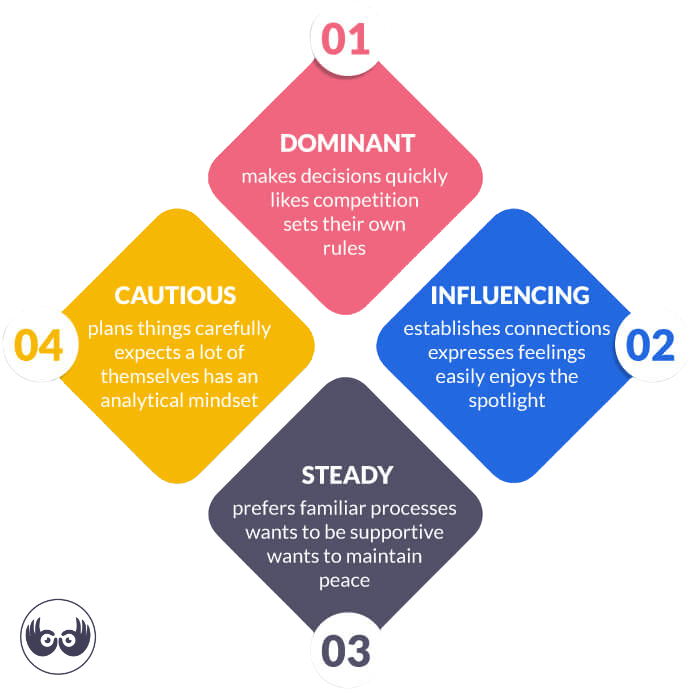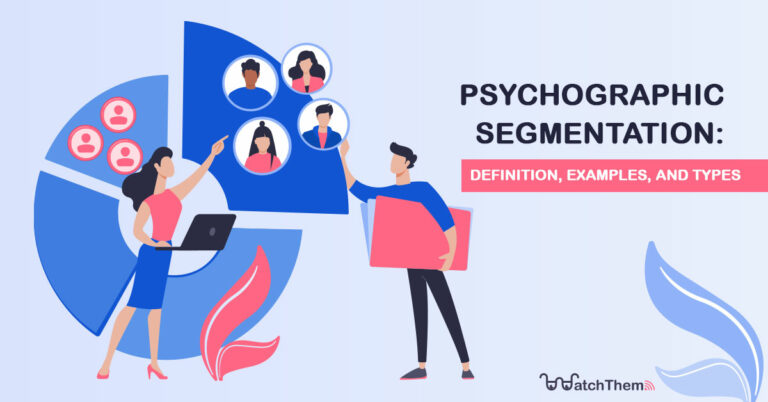Page Contents
Customer psychographic segmentation is a new approach in marketing. It starts by answering the question, ‘why each customer group buys the goods and services you offer?’
In conventional methods, marketing gurus define customer personas based on demographic data. They determine the most valuable customers’ age, gender, location, marital status, and profession. Interestingly, in digital marketing, such data are usually available through CRO tools or social media platform insights.
But, to have a better understanding of customers, some marketers examine psychographic parameters. These include the personality, activities, values, attitudes, and lifestyle of the target audience.
One of the best platforms that can help you gather your necessary data and increase your revenue is WatchThemLive. As an all-in-one CRO tool, WatchThemLive allows you to track your visitors throughout your website. Therefore you can know your customers better and identify areas for improvement.
So, before starting on psychographic segmentation definitions and examples, sign up for WatchThemLive with just a few clicks and see everything for yourself.
Types of Market Segmentation
Customer segmentation data types are split into five main categories:
Demographic, behavioral, geographical, psychographic, and transactional data.


- Demographic segmentation: Demographic segmentation segments your buyers based on age, income, gender, level of education, etc.
- Behavioral segmentation: Behavioral segmentation divides users based on their interaction with your website. You can understand users’ behavior by using an analytics tool and gathering that data to segment your customers effectively. Behavioral data include shopping habits, browsing habits, brand loyalty, etc.
If you want to gather your website visitors’ behavioral data, session replay tools such as WatchThemLive can help you see how each visitor behaves on your website. With session replays you can record and play customers’ journeys from the beginning to the very end, so you can find what they like, dislike, and come up with strategies according to that. Watch this video to see how they work:
The most useful feature, in this case, is website analytics which gives you valuable data about your users. Using web analytics, you can segment your customers based on their devices, browsers, languages, etc. It also allows you to track your pageviews and other data such as referees and users’ countries. This platform provides you with all these services and more. This way, you can make your customers’ persona even better, which will lead to better campaigns and sales in the end.
- Geographic segmentation: Geographic segmentation divides people into groups based on their physical location. It gives you information about users’ countries, cities, regions, and postal codes.
- Transactional segmentation: On the other hand, transactional data reveals what customers buy. At the same time, psychographic data complement these data types for comprehensive customer segmentation.
- Psychographic segmentation: Psychographic segmentation is a way of grouping customers based on their interests and personalities. Psychographic data gives you information about users’ goals, lifestyles, beliefs, hobbies, etc.
Any company that wants to understand its customers’ cognitive processes and base its business on customer-centric marketing, can benefit from the psychographic segmentation method. Moreover, it is one of the most successful segmentation approaches when used with other customer segmentation types.
Now, if you are wondering what is psychographic segmentation, then here’s the definition of it:
Psychographic Segmentation Definition
Psychographic segmentation is a methodology used to divide the market. The psychological characteristics of people are the basis of segmentation because people’s lifestyles and preferences influence consumption patterns. Therefore, psychographic segmentation is mainly based on how people think and see their lives and aspirations.
Customer personality and shopper habits are interconnected. Therefore, businesses offering value to clients based on their routine requirements can create a successful product or service.
If companies apply these characteristics to produce goods, they can significantly improve sales. For example, some liquor, laptop, vehicle, and perfume producers use their customers’ personalities as the basis of tailoring their marketing efforts.
How to Collect the Data for Psychographic Segmentation
The customer data needed for psychographic segmentation is mostly qualitative. Therefore, it’s often collected through surveys, questionnaires, interviews, or quizzes. Here are 3 major methods of data collection for psychographic segmentation:
#1 Interviews
By interviewing your existing customers, you can collect valuable data on who your customers are and what characteristics they have. This will help you in your future business plans as you know who you need to target and what traits they should have to become potential customers.
To gather data for your online business, you can send out surveys and ask your questions. But transparency is crucial! So make sure to explain to your customers why you need this data and how it helps you to grow your business.
#2 Website Analytics
If you haven’t been paying attention to your website analytics, you’re missing out on what your competitors are using to their advantage. By using a powerful website analytic tool, you can gain deep insight into your customers’ behavior and actions.
Where are your customers clicking on the most? What keeps them engaged? How are they surfing through your content? These are all questions that can impact your revenue greatly.
WatchThemLive will leave no blind spot as it’s one of the most powerful session replay tools in the market! You can understand everything your users do, and how they interact with your website.
Using various filters, you can surf through your recordings and find the ones you need! WatchThemLive will allow you to build your business strategies based on facts and without any guesswork.
#3 Focus Groups
It consists of a small group of people who match your target audience but are normally not affiliated with your business. You can discuss your products and services with them and gain valuable insight into your target audience’s needs and desires.
You need to be careful when you’re choosing the participants as they need to be impartial, and represent your target audience.
What Is the Difference Between Psychographic Segmentation & Demographic Segmentation
As we mentioned earlier, demographic segmentation is defined as grouping individuals based on age, gender, income, etc. But it’s not uncommon for individuals in the same demographic group to behave differently. That’s why psychographic segmentation can complement your marketing segmentation greatly.


Ideally, the optimum approach is to consider both demographics and psychographics. However, accessing a combination of data based on different methods enables you to have a holistic perspective toward your customer groups.
In order to choose the best marketing segmentation method, you need to know the differences they have. So here’s a list of differences between psychographic segmentation and demographic segmentation to help you out!
- Demographics are based on external factors such as age, location, and gender. But psychographic segmentation focuses on psychological traits such as motives, beliefs, and values.
- Psychographic segmentation is less straightforward compared to demographics, but the results can help build more detailed customer profiles.
- The strength of psychographic segmentation is its acknowledgment of peoples’ differences. On the other hand, demographic segmentation can be misleading at times as it only takes physical factors into consideration.
- Demographic data is easier to obtain and less expensive to conduct.
- Demographic segmentation is a great starting point for developing a business plan. But in order to have deeper insight, you need to use psychographic segmentation.
Why Is Psychographic Segmentation Important
Psychographic segmentation is important because it lets businesses understand their users’ lifestyles, behavior, shopping habits, and interests, which are key to understanding the reason behind their actions. By implementing psychographic segmentation, you will know why customers would buy your product or turn to competitors. This helps you develop effective marketing campaigns that result in more revenue.
Advantages of Psychographic Segmentation
Psychographic segmentation has so many advantages. Let’s review some of them here.
- Psychographic segmentation is useful for personalization. When you know what your customers are interested in, you can run personalized campaigns and increase your revenue.
- It helps you increase customer loyalty. Customers will stick with you if they feel you care about and understand them.
- Psychographic segmentation helps you understand your competitors’ audiences better. Using similar variables to examine competitors’ target markets, you can plan more effective marketing strategies.
- It helps understand consumer behavior.
- psychographic segmentation allows marketers to segment customers based on their views and opinions and supplements behavioral segmentation.
- It is more effective than geographic or demographic segmentation since it gives information about buyers’ internal qualities, such as hobbies, habits, and opinions.
Psychographic Segmentation Examples In Marketing
Nothing helps with better understanding a subject than going over some examples. Psychographic segmentation examples include:
1. Jewelry Brands
Consider a jewelry company that specializes in personalized accessories. Jewelry is a luxury item that appeals to people of the upper class who have a lot of money; that is, people whose social class and income levels allow them to buy such luxuries.
2. Plant-Based Food Company
Take as an example a company that creates plant-based processed foods. This product targets people who follow a specific diet, such as vegetarians or pescatarians.
3. Baby Products
Baby food and diapers, for example, have a unique target audience: families and new parents. These groups can be further divided based on consumer preferences and the many applications of your product.
Psychographic Segmentation Types
The most important types of psychographics are personality, activities and interests, attitudes and beliefs, values, and lifestyle. All of these types are examinable closely for each individual. Interestingly, they tell us what people do, how they think, and what is valuable to them.
1- Personality
Biological and environmental factors form personality, affecting specific behavioral, emotional, and cognitive traits. Therefore, market analysts can perform a personality segmentation to divide customers with similar personality traits.
Different products and services can appeal to different personalities. Also, you can create new functionalities for the examined personalities.
Here are some of the personality types that are useful for customer segmentation:
- Introvert,
- Extrovert,
- Emotional,
- Friendly,
- Creative.
Each psychological model categorizes personality types differently. For example, two of the most popular models are MBTI with its 16 personality types, and the DISC model. You can use any model you prefer that suits your business and customers better.


2- Activities and Interests
This psychographic market segmentation focuses on what activities consumers do, what they are passionate about, or their views on particular issues. These are AIO parameters, abbreviated from Activities, Interests, and Opinions.
Market researchers can identify favored goods and services based on behavior analytics. Moreover, they can develop marketing campaigns to appeal to various activities, preferences, and views.
A psychographic segmentation example of this variable is Johnnie Walker’s label using the “Game of Thrones.” It was targeting those interested in this series and drinking whiskey.
3- Attitudes and Beliefs
Childhood and cultural history shape an individual’s attitude. As a result, each prospect has a unique mindset, which is helpful as a predictor in psychographic segmentation.
So, you can divide customers into groups based on their beliefs and perceptions. Beliefs are an intrinsic parameter that gives insights into a customer’s fundamental behavior.
Each user has a unique mindset and attitude. Consider these factors when determining the target market for a new product or feature.
4- Values
Values are referred to the sense of right and wrong among people. They can include family, social, and environmental values, to name a few. Identifying which values and virtues are relevant to your most valuable customers can help you target them.
An example of this psychographic segmentation is IKEA’s sustainability campaign focusing on the brand’s attention to an environmental cause.
As value is a complex psychographic segmentation parameter, you can track online activity to determine your target market values.
5- Lifestyle
Manufacturing a variety of products for various customers needs a huge investment. However, segmenting products based on lifestyle can make product development and marketing efforts more targeted and cost-efficient.
For example, a shoe designer can design shoes for different consumer segments such as office workers, athletes, runners, students, etc. Thus, segmenting categories based on consumers’ lifestyles leads to an improved product and a more effective advertising campaign.
How to Use Psychographic Segmentation
Knowing what this marketing strategy is, is pointless if you don’t know how to use it! Psychographic segmentation can help you improve your results greatly if used properly. Let’s see some examples of how you can use it to improve your business.
1. Give Your Users What They Need
When you know your customers, you can motivate them with what they desire. For example, people need to hear from your other buyers that your skin product can remove their pimples in one month. So, in this case, offering free shipping or discounts won’t help. You need testimonials for your next marketing campaign to get people to buy your products.
2. Use the Social Media Platforms They Use
One of the most useful information psychographic segmentation gives you is your user’s most favorable social media platforms. If they spend most of their free time on Instagram or use this platform for online shopping, you should stop spending your time and money on Facebook and focus on bettering your Instagram business account. Observe what kind of content they like and engage with to know them even more and create your content according to that.
3. Emphasis on Their Interests and Hobbies
Let’s imagine you own a book store and through psychographic segmentation, you find out that your customers like it when a loved one reads a book to them.
Here, you should use images of couples that comfortably lay beside each other and one of them is reading a book to the other. You can also recommend the best books that couples can enjoy or write content about how fun and relaxing it is to read a book with someone you love.
Whatever your business is about, try to somehow relate your buyers’ interests and hobbies to the content you create, be it a blog post, a social media post, an ad, etc.
4. Create Customized Calls to Action
CTAs are very important for businesses, especially if they run a blog. As you may already know, ordinary CTAs won’t work in this age of competition. Psychographic segmentation allows you to design your CTAs in a way that’s appealing to your customers.
For example, if you sell decoratives, you should use a CTA copy like this “Start your path to create the dream house you always wanted.” You can also use an image of a beautiful house decorated with your goods. Or an image of a happy family living in that house.
Disadvantages of Psychographic Segmentation
Even though psychographic segmentation is a great way to narrow down your audience and know your users better, there are a few disadvantages to this market segmentation technique too. Here are some of them!
- It can be an expensive method. In order to have accurate psychographic segmentation data, you need a high-quality market research method that is often expensive, especially for startups and small businesses.
- Psychographic segmentation is harder to perform compared to other marketing segmentation methods.
- It’s not the only factor that defines the cause behind customers’ purchases and actions. So it can be misleading as other factors affect the overall outcome as well.
Psychographic Segmentation FAQs
Now that you know everything about psychographic segmentation definition and its examples, it’s time to go over frequently asked questions about this subject.
Q1. What Is Psychographic Segmentation in Marketing?
It’s the act of grouping the market based on their psychological characteristics such as attitude, lifestyle, social status, etc. This will allow you to have a clear view of your target audience and save time and resources.
Q2. What Are 2 Psychographic Segmentation Examples?
For example, a clothing store downtown whose customers are mostly of lower social status focuses more on durability and lower prices rather than unique designs and branding.
Another example of psychographic segmentation can be a restaurant that targets upper-class individuals. These people exhibit different kinds of attitudes and are more drawn to luxury items and premium restaurants. So this restaurant knows what kind of food to provide and how much to spend on luxury items in the design.
By keeping that in mind and targeting the right audience when launching a new business or introducing a new product or service, your chances of getting more customers will be significantly higher.
Q3. How Can Psychographic Segmentation Help Marketers?
It helps you identify areas for improvement, attract more potential customers, and create more targeted and stronger marketing campaigns.
You can also use psychographic segmentation to gain valuable information about the connection between customers’ beliefs and personalities and their shopping habits. This will allow you to deliver a more personalized and exceptional buying experience.
Last Words on Psychographic Segmentation
Now you know the answer to ‘what psychographic segmentation is’ and its types and saw some examples. We should add that psychographic data can complement demographic, behavioral, geographical, and transactional data for complete market segmentation. It’s helpful to use and analyze these data types if companies want to take customer-oriented marketing.
For this purpose, you can use behavioral analytics software like WatchThemLive and truly understand your customers. So make sure to Sign up and seize your FREE plan now!

